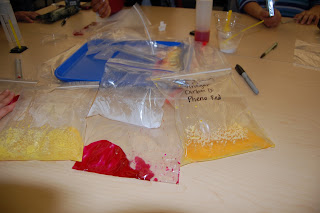Science in the Classroom
Wednesday, March 9, 2011
Fantastic in a Bag! The Chemical Reaction to Silly Putty
Today our group presented the Chemical Reaction in Glow in the Silly Putty. We started with an introduction to the definition of chemical reaction. The students seemed to have previous knowledge about chemical reaction, they knew more information than we anticipated, because of this, we modified our presentation and continued to the different types of chemical reactions. In this section, Melanie explained the various types of chemical reactions: physical, odor, liquid to gas, color and temperature. We had the students predict what chemical reaction they believed would respond in this experiment. The students chose the correct types of chemical reactions, again amazed us at the background knowledge that they had. I presented the steps to the experiment, emphasizing that measurement was very important. We combined liquid starch, glue, food coloring and glow in the dark paint. The students placed these ingredients in a ziploc bag and mixed them in the bag. It was a success and a wonderful learning experience!
Saturday, February 19, 2011
Chocolate and Chemistry
Exploring real objects in science class allows the students to make connections and be more engaged in an activity in which they can relate to. In a group, we created a glogster that explored the science of chocolate. Specifically, the chemistry and chemical reaction that are required to make the delicious chocolates that many of us love. Connecting real objects and those that are of interest to the students, allows the students become more engaged in the activity, which then increases their learning in the subject. Take a look at the glogster that my group and I created! Enjoy!

Ready, Set GO!
Today we created our own cars made from cardboard, wooden wheels, sticks, butterfly clips, ruber bands and clothespins. This was my first time making a small modeled car, the experience was inspiring! It was difficult think about the creation of a car that would be fast and stable. Our group experience trial and error as we went through the steps of the scientific method:
1. Ask a question
2. Do background research
3. Construct a hypthesis
4. Test your hypothesis
5. Analyze your data and draw a conclusion
6. Communicate your results
After creating our car, we raced them down the hill! Our car did not successfully function, the wheels had trouble turning, however the experience was fun and engaging! This activity would absolutely be a wonderful experiment to do with the students. It requires you to critically think about how cars function and the process of the scientific method to complete the activity.
Friday, February 18, 2011
Chemical Reaction
Chemistry in the classroom can be creative and engaging. Today we experience a fun, interacting and engaging activity in which we mixed chemicals, observed, made theories and concluded about the mixture of the chemicals. Engaging students in Chemistry or any other science activity requires a "hook." This "hook" is an activity that grabs the students' interests and produces an engaging, productive lesson. The "hook" for todays class was reading about the various mixtures of chemicals in objects that we see in our every day life. For example, when apples turn brown this is a chemical reaction. Reading about real objects "hooked" us into asking questions about chemical reactions and caught our interest in participating in the activity. In chemistry activity, we mixed various chemicals and tested the mixture to observe the reaction and what caused the reaction.
Field Trip to the Arboretun!
 |
| Right: Me, Valerie, Kristen |
 |
| A "closer" look at a beatle found in the desert |
Thursday, January 27, 2011
Lucy Leafy
Creating a podcast requires patience and creativity, a skill in which we practiced today. With a partner, Marlene, we created a podcast that told a story about a tree on campus. The steps incuded, choosing a tree, taking pictures from different percentages, and creating a podcast. The angles of the pictures differentiated in how close we took the picture. One picture included the tree as a whole, and we then began to zoom in. In creating the podcast, Marlene and I had to be creative and think of the story we wanted the tree to inform its audience. We thought about telling the story of the generations it has seen on campus. Creating the podcast required a large amount of patience, it gave Marlene and I very good practice for future podcast creations.
Science Journal Cover
Science journals are a creative and interactive form for students to reflect on classroom and homework assignments. It allows the students to reflect on observations, experiments and ask questions about any activity they participated in. Decorating your journal to your own style also allows the students to make it their own and more personal. This is a picture of my designed journal. I have included pictures that convey what science means to me. In my pictures I have included chemistry, biology, astrology, and some well known science individuals, Albert Einstein and Bill Nye the Science Guy.
Subscribe to:
Comments (Atom)






